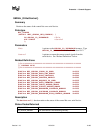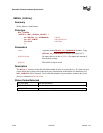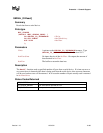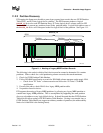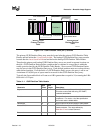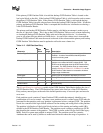
Extensible Firmware Interface Specification
11-4 12/01/02 Version 1.10
11.2 File System Format
The file system supported by the Extensible Firmware Interface is based on the FAT file system.
EFI defines a specific version of FAT that is explicitly documented and testable. Conformance to
the EFI specification and its associate reference documents is the only definition of FAT that needs
to be implemented to support EFI. To differentiate the EFI file system from pure FAT, a new
partition file system type has been defined.
EFI encompasses the use of FAT32 for a system partition, and FAT12 or FAT16 for removable
media. The FAT32 system partition is identified by an OS type value other than that used to
identify previous versions of FAT. This unique partition type distinguishes an EFI defined file
system from a normal FAT file system. The file system supported by EFI includes support for
long file names.
The definition of the EFI file system will be maintained by specification and will not evolve over
time to deal with errata or variant interpretations in OS file system drivers or file system utilities.
Future enhancements and compatibility enhancements to FAT will not be automatically included in
EFI file systems. The EFI file system is a target that is fixed by the EFI specification, and other
specifications explicitly referenced by the EFI specification.
For more information about the EFI file system and file image format, visit the web site from which
this document was obtained.
11.2.1 System Partition
A System Partition is a partition in the conventional sense of a partition on a legacy Intel
architecture system. For a hard disk, a partition is a contiguous grouping of sectors on the disk
where the starting sector and size are defined by the Master Boot Record (MBR), which resides on
the first sector of the hard disk. For a diskette (floppy) drive, a partition is defined to be the entire
media. A System Partition can reside on any media that is supported by EFI Boot Services.
A System Partition supports backward compatibility with legacy Intel architecture systems by
reserving the first block (sector) of the partition for compatibility code. On legacy Intel architecture
systems, the first block (sector) of a partition is loaded into memory and execution is transferred to
this code. EFI firmware does not execute the code in the MBR. The EFI firmware contains
knowledge about the partition structure of various devices, and can understand legacy MBR, EFI
partition record, and “El Torito.”
The System Partition contains directories, data files, and EFI Images. EFI Images can contain an
EFI OS Loader, an EFI Driver to extend platform firmware capability, or an EFI Application that
provides a transient service to the system. EFI Applications could include things such as a utility to
create partitions or extended diagnostics. A System Partition can also support data files, such as
error logs, that can be defined and used by various OS or system firmware software components.




